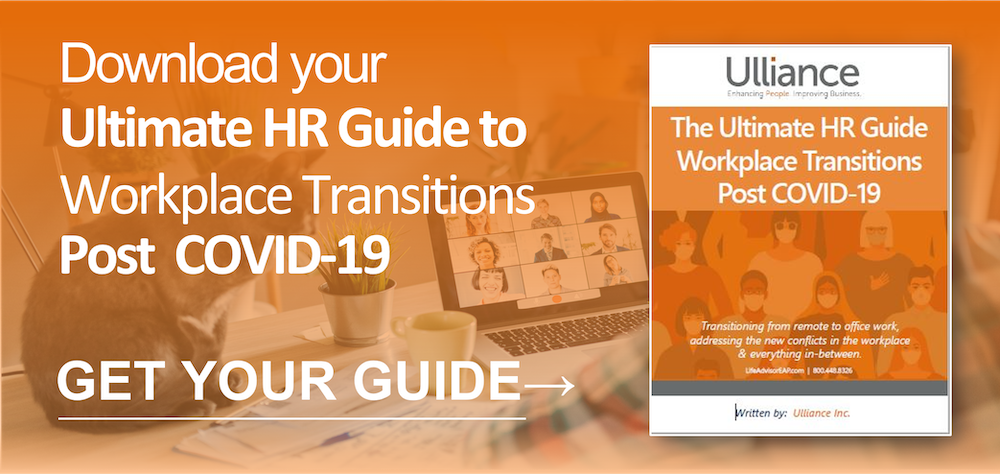Everyone Has an Opinion
The pandemic has changed almost everything about how people go about their daily lives, most notably the way they work. Priorities have shifted, and opinions have been formed, leaving a bold line separating those who agree with current COVID guidelines and those who do not.
Then some choose to stand on the line. They don't necessarily agree, but they don't entirely disagree either.
With their differing thoughts and beliefs, all these people will come together in a workspace that is turning into a battleground. COVID conflicts and confrontations between employees are leading to disagreements about the proper wearing of masks, maintaining a safe distance and sanitary workstations.
On one end of the spectrum, some employees complain when workers lower their masks below their noses. On the other end, workers complain that an employee's constant sanitizing and disinfectant spraying is out of control and creates a breathing hazard. Keeping your workers safe and the environment hostile-free while encouraging communication and teamwork will be tricky.
Now that the crisis response is over, you must make time to reflect on what's next and take action on the recovery process. This requires hearing different perspectives from people at all levels at the beginning of the process and consistent reevaluation and adjustment as you move forward.
So what's next? Policies, Boundaries, and Respect.
1.) Updating Workplace Policy and Procedure
Undoubtedly, there will be changes to the work environment. Specific measures must be taken for the protection of employees. Some of these new policies may be your own, while others will be because of legal requirements or public health authorities' recommendations.
Either way, you should recognize the precautions as an inconvenience and reassure workers that the changes are temporary and stress the importance of compliance by everyone since "you're all in this together."
Informing employees about the "why" of each COVID protocol can help with compliance and mitigate interpersonal conflict. Being open to hearing employee concerns and honest, sincere answers to their questions can ease fears and reinforce your commitment to keeping everyone safe.
2.) Setting Boundaries When Working from Home or the Office
Working Americans not only rose to the occasion during the pandemic by adapting to new working conditions, but they also went above and beyond by increasing their workday by 6.1% in 2020.
At first glance, you may think, "way to go!" However, dedicating more hours to the job means you take hours from other parts of your life. It's easy to fall into the habit of checking your email before you go to bed or looking over one more report before you cook dinner.
Employers and co-workers know everyone has easy access to their computers at home, and rather than wait until the next workday to send that urgent email, they hit send at 9 pm, hoping you'll take care of it right away, and you do.
Boundaries keep you sane in a crazy world. During this pandemic, they also keep you 6 feet away from everyone else. How do you set them up to work for you without sounding harsh or being rude?
• Co-Workers –
The key to setting boundaries with your co-workers or your team is to communicate your expectations. Be clear about things like what time your day begins and ends, if you can be reached on your lunch hour and when you are available for meetings during the day.
Once you have established your parameters, don't waver on them. If your day ends at 5 pm, then make sure you are not available after 5 pm. Sending mixed messages by sometimes working until 6 pm leaves everyone uncertain as to whether they should expect you to be available or not.
• BOSSES –
It can feel intimidating and awkward to set boundaries with your boss. They are in charge of your workday and happen to be the one who reviews your performance and determines if you are going to get a raise.
They set the expectations and give directives, not the other way around. But if you are going to have a healthy work-life balance, clear communication with your boss is a must.
Be sure to ask for what you need, whether it be time off, a longer lunch or flexibility in scheduling. Go into the conversation expecting to compromise and keep venting and complaining out of the equation. A simple explanation for your request is all that is needed.
3.) Respect Others - Even when they have a different opinion
"Respect is like air. As long as it's present, nobody thinks about it. But if you take it away, it's all that people can think about."
Quote from the book Crucial Conversations
Infringing on other people's beliefs is disrespectful and creates a hostile work environment. Employees who sense hostility from a co-worker or feel undervalued by the team find it almost impossible to do their job. And remember, just because you didn't mean to disrespect someone or you didn't realize it, it still has a significant negative impact.
This past year brought "crazy" to a new level. The economic, political, and social upheaval was rampant, and leaders faced challenging situations in trying to ensure civility and fairness in the workplace.
As a leader, you can teach others how to show respect by doing the following:
• Look for diverse perspectives –
Regardless of how unintentional, workplace bias and discrimination exist in almost all companies. To combat this, employers should intentionally seek out and respond to input from diverse backgrounds.
• Give Feedback –
Employees like to know how they are doing. Giving feedback is a great way to show your employees they are valued and that you recognize the strengths, they bring to the job.
Constructive feedback also shows respect because it indicates that you trust the employee enough to be open and honest about improving.
As a co-worker, you can show respect to other workers by understanding that everyone has the right to make the choices they believe are best for them. Also, by valuing their opinion even if it is different from yours, you are saying, "I hear you," and everyone wants to be heard.
4.) Support Your Team’s Emotional Health at Work and Beyond
Be on the lookout for signs of mental distress in your team. Data shows that the prevalence and severity of things like depression, anxiety, and substance use have surged since the spread of COVID-19 began, especially as a result of social distancing measures.
• Keep the lines of communication open-
If your employee’s typical behaviors have changed for more than a few days, this could be a sign of trouble ahead. For example, a normally outgoing personality type now seems withdrawn and quiet. If you notice changes, it’s okay to talk privately and respectfully with your team member about the changes you’ve noticed, and ask them if they’re okay, or if they need assistance. This conversation can take place both in-person and virtually.
• Be proactive-
As leaders, it’s important to make mental health a priority, not just when you suspect a problem. Talking about emotional health in a proactive way can ease the stigma that some feel when they’re experiencing challenges. Make it a normal part of discussions in staff meetings and one-on-one discussions. It’s critical that managers consider strategies that make employees more comfortable with speaking up if they’re facing challenges.
• Get additional guidance from your EAP-
Your EAP Account Manager has a mental health background and can help you gain valuable insight about any concerns you have about an employee’s emotional well-being. Your Account Manager can help you with appropriate next steps, including advice on talking with your employee, or making a referral to the Employee Assistance Program.
Don't have an EAP? Connect with us we would love to chat with you about how we can help.
5.) Take Care Leaders – Leadership Burnout
Burnout has recently been recognized as an “occupational phenomenon.” According to the World Health Organization (WHO), burnout is a syndrome resulting from chronic workplace stress that has not been successfully managed. It is characterized by three dimensions:
• Feelings of energy depletion or exhaustion
• Increased mental distance from one’s job,
or feelings of negativity or cynicism related to one’s job
• Reduced professional efficacy
Burnout is a combination of the work we do and organizational stressors. It is different than stress in that burnout is always linked to your job; stress is not.
There Is a Solution:
Stress will always be a part of the human experience. That doesn’t mean it can’t be effectively addressed and the solutions are easier than we may think.
The Power of Resiliency:
Psychologists define resiliency as the process of adapting well in the face of trauma, tragedy or everyday sources of stress, including family and relationship concerns, or workplace and financial challenges. If we can find ways to adapt and cope effectively, we lower the likelihood that stress and burnout will create more problems. Perhaps even more importantly, we will be more adequately prepared for the next challenge.
(For more tips click here to get your comprehensive post-COVID HR toolkit)
There are certain traits and habits that increase the likelihood one can maintain ongoing resiliency in the face of adversity:
1. Being optimistic in a realistic way.
2. Having a moral compass to guide your beliefs and actions.
3. A belief in something greater than oneself
(not necessarily of a religious nature).
4. Emotional and cognitive flexibility. Seeing things in “gray” and avoiding rigid or absolutes in your thinking and feeling. Practicing mindfulness can help develop this flexibility.
5. Strong, healthy connections to others.
Getting along and creating a state of total well-being for all in a post-Covid workforce may be a bit challenging, but just like everything else COVID-related, it is a learning process. The path you take today may end in a dead-end. Tomorrow you refine your approach and try again.
Most of all, remember that respect is a two-way street. You get what you give.
When you partner with Ulliance, our Life Advisor Consultants are always just a phone call away to teach ways to enhance your work/life balance and increase your happiness. The Ulliance Life Advisor Employee Assistance Program (a total Well-being Program) can help employees and employers come closer to a state of total well-being.
References:
Callahan, C. (2020, December 08). How to set boundaries with your co-workers, boss, and yourself during COVID-19. Retrieved from TODAY: https://www.today.com/tmrw/how-set-healthy-boundaries-work-home-during-covid-19-t202257
J.D, L. N.-P. (2020, September 16). How to Resolve Co-Worker Conflicts over Coping with COVID-19. Retrieved from SHRM: https://www.shrm.org/resourcesandtools/legal-and-compliance/employment-law/pages/-co-worker-conflicts-over-coping-with-covid-19.aspx
Workplace Respect Matters During COVID. (n.d.). Retrieved from LSA Global: https://lsaglobal.com/blog/workplace-respect-during-covid/



